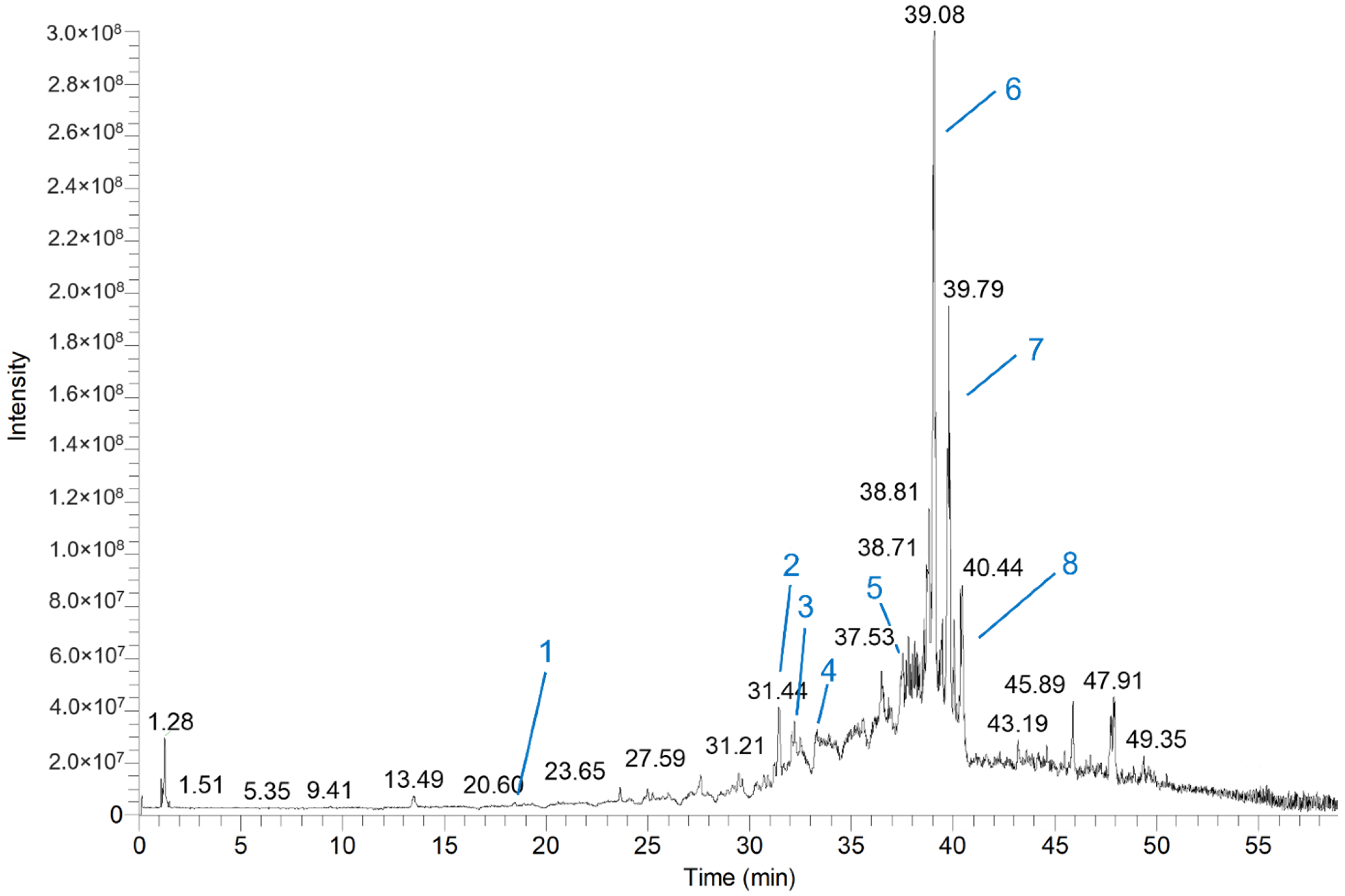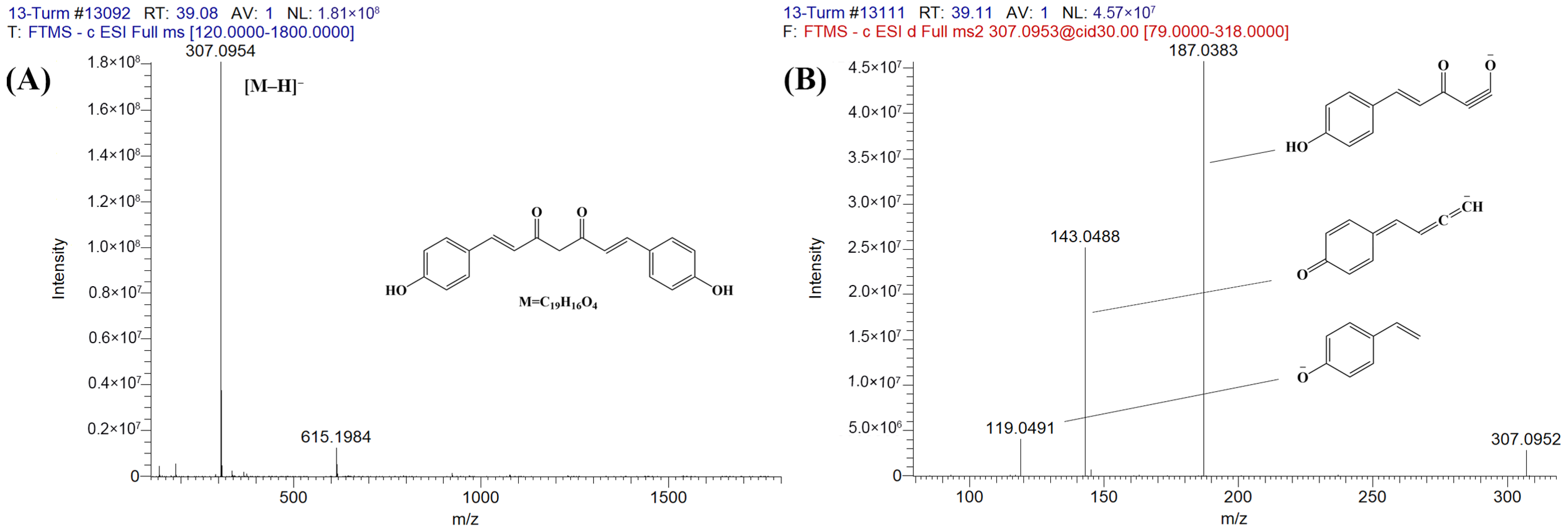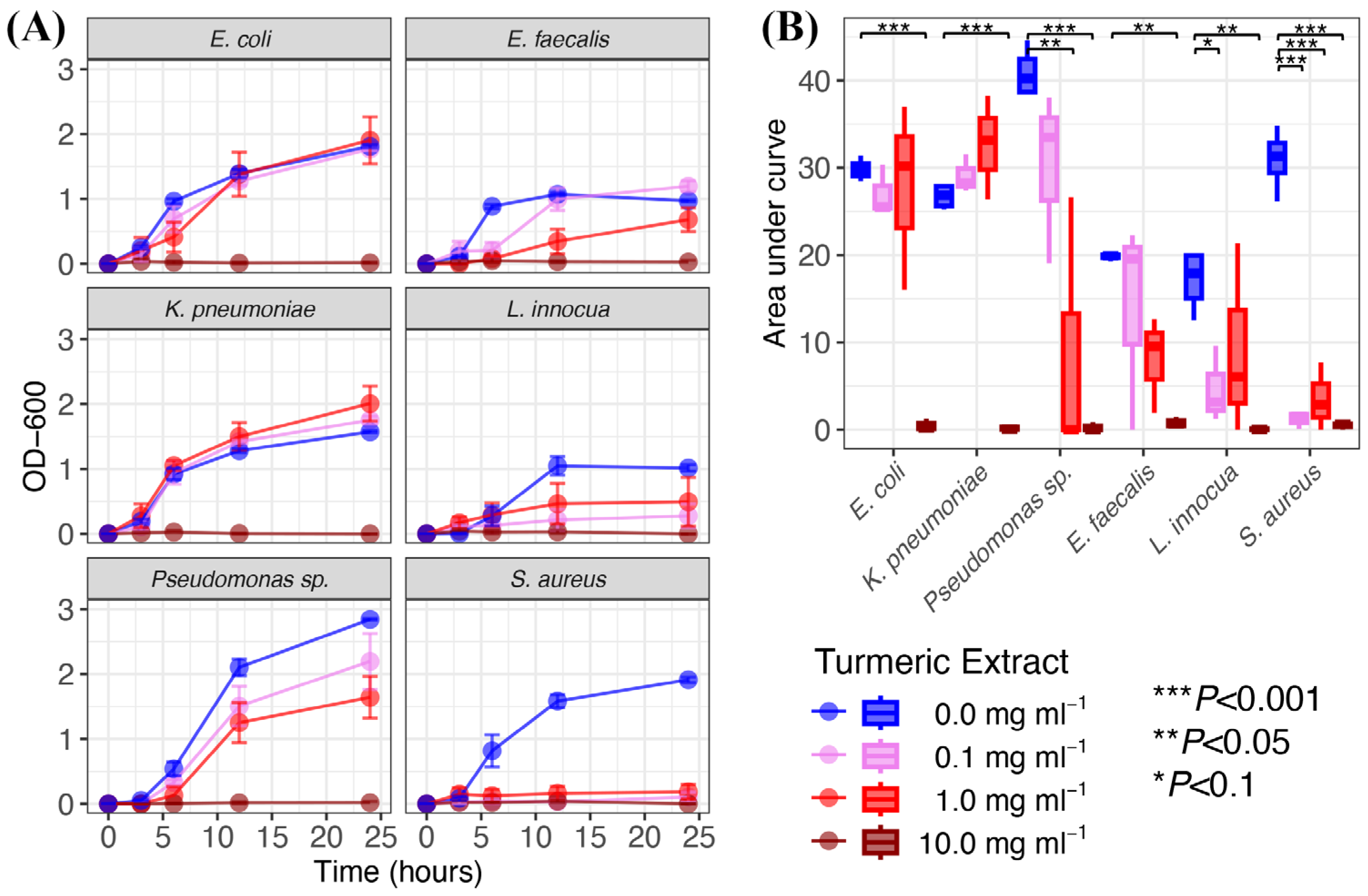Chemical Composition of Turmeric (Curcuma longa L.) Ethanol Extract and Its Antimicrobial Activities and Free Radical Scavenging Capacities
Abstract
:1. Introduction
2. Materials and Methods
2.1. Materials
2.2. Sample Preparation
2.3. Chemical Compositions of Turmeric (Curcuma longa L.) Ethanol Extract
2.4. Antimicrobial Activities
2.5. Total Phenolic Content (TPC)
2.6. Free Radical Scavenging Capacities
2.7. Statistical Analysis
3. Results and Discussion
3.1. Chemical Compositions of Turmeric Ethanol Extract
3.2. Antimicrobial Activities
3.3. TPC and Free Radical Scavenging Capacities
4. Conclusions
Supplementary Materials
Author Contributions
Funding
Institutional Review Board Statement
Informed Consent Statement
Data Availability Statement
Conflicts of Interest
References
- Hay, E.; Lucariello, A.; Contieri, M.; Esposito, T.; De Luca, A.; Guerra, G.; Perna, A. Therapeutic Effects of Turmeric in Several Diseases: An overview. Chem. Biol. Interact. 2019, 310, 108729. [Google Scholar] [CrossRef] [PubMed]
- Zagórska, J.; Kukula-Koch, W.; Czop, M.; Iłowiecka, K.; Koch, W. Impact of Thermal Processing on the Composition of Curcuma longa Rhizome. Foods 2023, 12, 3086. [Google Scholar] [CrossRef] [PubMed]
- Idowu-Adebayo, F.; Fogliano, V.; Linnemann, A. Turmeric-Fortified Cow and Soya Milk: Golden Milk as a Street Food to Support Consumer Health. Foods 2022, 11, 558. [Google Scholar] [CrossRef] [PubMed]
- Wikipedia. Available online: https://en.wikipedia.org/wiki/Turmeric (accessed on 9 March 2024).
- Rahmat, E.; Lee, J.; Kang, Y. Javanese Turmeric (Curcuma xanthorrhiza Roxb.): Ethnobotany, Phytochemistry, Biotechnology, and Pharmacological Activities. Evid. Based Complement. Alternat. Med. 2021, 2021, 9960813. [Google Scholar] [CrossRef] [PubMed]
- Hewlings, S.J.; Kalman, D.S. Curcumin: A Review of Its Effects on Human Health. Foods 2017, 6, 92. [Google Scholar] [CrossRef] [PubMed]
- The Global Curcumin Market Is Projected to Grow from $85.77 Million in 2023 to $165.10 Million by 2030, at a CAGR of 9.81% during the Forecast Period, 2023–2030. Available online: https://www.fortunebusinessinsights.com/industry-reports/curcumin-market-101453 (accessed on 9 March 2024).
- Shahrajabian, M.H.; Sun, W. The Golden Spice for Life: Turmeric with the Pharmacological Benefits of Curcuminoids Components, including Curcumin, Bisdemethoxycurcumin, and Demethoxycurcumin. Curr. Org. Synth. 2023, 21, 665–683. [Google Scholar] [CrossRef] [PubMed]
- Wang, Z.; Singh, A.; Jones, G.; Winzenberg, T.; Ding, C.; Chopra, A.; Das, S.; Danda, D.; Laslett, L.; Antony, B. Efficacy and Safety of Turmeric Extracts for the Treatment of Knee Osteoarthritis: A Systematic Review and Meta-analysis of Randomised Controlled Trials. Curr. Rheumatol. Rep. 2021, 23, 11. [Google Scholar] [CrossRef] [PubMed]
- Ostadi, A.; Arab-Zozani, M.; Zarei, E.; Ferns, G.A.; Bahrami, A. Therapeutic Effect of Turmeric on Radiodermatitis: A Systematic Review. Physiol. Rep. 2023, 11, e15624. [Google Scholar] [CrossRef]
- Kuttan, R.; Sudheeran, P.C.; Josph, C.D. Turmeric and Curcumin As Topical Agents in Cancer Therapy. Tumori J. 1987, 73, 29–31. [Google Scholar] [CrossRef]
- Dai, C.; Lin, J.; Li, H.; Shen, Z.; Wang, Y.; Velkov, T.; Shen, J. The Natural Product Curcumin as an Antibacterial Agent: Current Achievements and Problems. Antioxidants 2022, 11, 459. [Google Scholar] [CrossRef]
- Hussain, Y.; Alam, W.; Ullah, H.; Dacrema, M.; Daglia, M.; Khan, H.; Arciola, C.R. Antimicrobial Potential of Curcumin: Therapeutic Potential and Challenges to Clinical Applications. Antibiotic 2022, 11, 322. [Google Scholar] [CrossRef] [PubMed]
- Sadeghi, M.; Dehnavi, S.; Asadirad, A.; Xu, S.; Majeed, M.; Jamialahmadi, T.; Johnston, T.P.; Sahebkar, A. Curcumin and Chemokines: Mechanism of Action and Therapeutic Potential in Inflammatory Diseases. Inflammopharmacology 2023, 31, 1069–1093. [Google Scholar] [CrossRef] [PubMed]
- Ansel, H.C.; Norred, W.P.; Roth, I.L. Antimicrobial activity of dimethyl sulfoxide against Escherichia coli, Pseudomonas aeruginosa, and Bacillus megaterium. J. Pharm. Sci. 1969, 58, 836–839. [Google Scholar] [CrossRef] [PubMed]
- Yu, L.; Haley, S.; Perret, J.; Harris, M.; Wilson, J.; Qian, M. Free radical scavenging properties of wheat extracts. J. Agric. Food Chem. 2002, 50, 1619–1624. [Google Scholar] [CrossRef] [PubMed]
- Cheng, Z.H.; Moore, J.; Yu, L.L. High-throughput relative DPPH radical scavenging capacity assay. J. Agric. Food Chem. 2006, 54, 7429–7436. [Google Scholar] [CrossRef]
- Yu, L. Free radical scavenging properties of conjugated linoleic acids. J. Agric. Food Chem. 2001, 49, 3452–3456. [Google Scholar] [CrossRef]
- Moore, J.; Yin, J.J.; Yu, L.L. Novel fluorometric assay for hydroxyl radical scavenging capacity (HOSC) estimation. J. Agric. Food Chem. 2006, 54, 617–626. [Google Scholar] [CrossRef]
- Sprouffske, K.; Wagner, A. Growthcurver: An R package for obtaining interpretable metrics from microbial growth curves. BMC Bioinform. 2016, 17, 172. [Google Scholar] [CrossRef]
- Wang, L.; Chen, C.; Su, A.; Zhang, Y.; Yuan, J.; Ju, X. Structural Characterization of Phenolic Compounds and Antioxidant Activity of the Phenolic-Rich Fraction from Defatted Adlay (Coix lachryma-jobi L. Var. Ma-Yuen Stapf) Seed Meal. Food Chem. 2016, 196, 509–517. [Google Scholar] [CrossRef]
- Liao, Y.; Zhang, X.; Cao, D.; Wang, F.; Chen, H.; Li, R. Separation and Identification of Terpene-conjugated Curcuminoids Based on Liquid Chromatography–Tandem Mass Spectrometry and Their In Vitro Anti-inflammatory Activities. J. Sep. Sci. 2023, 46, 2200789. [Google Scholar] [CrossRef]
- Abdul Zahar, Z.; Mohsin, H.F.; Ibtisam, A. The Study on Curcuminoids in Chromatography, Spectroscopy and Regioisomerism. J. Phys. Conf. Ser. 2020, 1529, 022035. [Google Scholar] [CrossRef]
- Alberti, Á.; Riethmüller, E.; Béni, S. Characterization of Diarylheptanoids: An Emerging Class of Bioactive Natural Products. J. Pharm. Biomed. Anal. 2018, 147, 13–34. [Google Scholar] [CrossRef]
- Yang, Q.Q.; Cheng, L.Z.; Zhang, T.; Yaron, S.; Jiang, H.X.; Sui, Z.-Q.; Corke, H. Phenolic Profiles, Antioxidant, and Antiproliferative Activities of Turmeric (Curcuma longa). Ind. Crops Prod. 2020, 152, 112561. [Google Scholar] [CrossRef]
- Woerner, D.R.; Geornaras, I.; Martin, J.N.; Belk, K.E.; Acuff, G.R.; Dickson, J.S. Use of Nonpathogenic Escherichia coli Surrogates as Predictors of the Survival of Nontyphoidal Salmonella, non-O157 Shiga Toxin-Producing Escherichia coli, and Escherichia coli O157 Populations after High Hydrostatic Pressure Processing. J. Food Prot. 2018, 81, 1068–1072. [Google Scholar] [CrossRef] [PubMed]
- Mohan, V.; Wibisono, R.; de Hoop, L.; Summers, G.; Fletcher, G.C. Identifying Suitable Listeria innocua Strains as Surrogates for Listeria monocytogenes for Horticultural Products. Front. Microbiol. 2019, 10, 2281. [Google Scholar] [CrossRef] [PubMed]
- Perrin, M.; Bemer, M.; Delamare, C. Fatal Case of Listeria innocua Bacteremia. J. Clin. Microbiol. 2003, 41, 5308–5309. [Google Scholar] [CrossRef]
- Thomas, G.A.; Paradell Gil, T.; Müller, C.T.; Rogers, H.J.; Berger, C.N. From field to plate: How do bacterial enteric pathogens interact with ready-to-eat fruit and vegetables, causing disease outbreaks? Food Microbiol. 2024, 117, 104389. [Google Scholar] [CrossRef] [PubMed]
- Turmeric Salad Dressing. Available online: https://www.mccormick.com/recipes/sauces/turmeric-salad-dressing (accessed on 9 March 2024).
- Santajit, S.; Indrawattana, N. Mechanisms of Antimicrobial Resistance in ESKAPE Pathogens. Biomed. Res. Int. 2016, 2016, 2475067. [Google Scholar] [CrossRef] [PubMed]
- Theocharidi, N.A.; Balta, I.; Houhoula, D.; Tsantes, A.G.; Lalliotis, G.P.; Polydera, A.C.; Stamatis, H.; Halvatsiotis, P. High Prevalence of Klebsiella pneumoniae in Greek Meat Products: Detection of Virulence and Antimicrobial Resistance Genes by Molecular Techniques. Foods 2022, 11, 708. [Google Scholar] [CrossRef]
- Driscoll, J.A.; Brody, S.L.; Kollef, M.H. The epidemiology, pathogenesis and treatment of Pseudomonas aeruginosa infections. Drugs 2007, 67, 351–368. [Google Scholar] [CrossRef]
- Li, X.; Gu, N.; Huang, T.Y.; Zhong, F.; Peng, G. Pseudomonas aeruginosa: A Typical Biofilm Forming Pathogen and an Emerging but Underestimated Pathogen in Food Processing. Front. Microbiol. 2023, 13, 1114199. [Google Scholar] [CrossRef] [PubMed]
- Giraffa, G. Enterococci from Foods. FEMS Microbiol. Rev. 2002, 26, 163–171. [Google Scholar] [CrossRef]
- Teuber, M.; Perreten, V.; Wirsching, F. Antibiotikumresistente Bakterien: Eine neue Dimension in der Lebensmittelmikrobiologie. Lebensm.-Technol. 1996, 29, 182–199. [Google Scholar]
- Gutiérrez, D.; Delgado, S.; Vázquez-Sánchez, D.; Martínez, B.; Cabo, M.L.; Rodríguez, A.; Herrera, J.J.; García, P. Incidence of Staphylococcus aureus and analysis of associated bacterial communities on food industry surfaces. Appl. Env. Microbiol. 2012, 78, 8547–8554. [Google Scholar] [CrossRef] [PubMed]
- Mun, S.H.; Joung, D.K.; Kim, Y.S.; Kang, O.H.; Kim, S.B.; Seo, Y.S.; Kim, Y.C.; Lee, D.S.; Shin, D.W.; Kweon, K.T.; et al. Synergistic Antibacterial Effect of Curcumin Against Methicillin-Resistant Staphylococcus areus. Phytomedicine 2013, 20, 714–718. [Google Scholar] [CrossRef] [PubMed]
- Choi, Y.; Kim, W.; Lee, J.S.; Youn, S.J.; Lee, H.; Baik, M.Y. Enhanced Antioxidant Capacity of Puffed Turmeric (Curcuma longa L.) by High Hydrostatic Pressure Extraction (HHPE) of Bioactive Compounds. Foods 2020, 9, 1690. [Google Scholar] [CrossRef] [PubMed]
- Akter, J.; Hossain, M.A.; Takara, K.; Islam, M.Z.; Hou, D.X. Antioxidant Activity of Different Species and Varieties of Turmeric (Curcuma Spp): Isolation of Active Compounds. Comp. Biochem. Physiol. Part C Toxicol. Pharmacol. 2019, 215, 9–17. [Google Scholar] [CrossRef] [PubMed]
- Decker, E.A.; Elias, R.J.; McClements, D.J. Oxidation in Foods and Beverages and Antioxidant Applications: Management in Different Industry Sectors; Woodhead Publishing Series in Food Science, Technology and Nutrition; Elsevier Science: Amsterdam, The Netherlands, 2010. [Google Scholar]
- Al Jumayi, H.A.; Allam, A.Y.; El-Beltagy, A.E.D.; Algarni, E.H.; Mahmoud, S.F.; El Halim Kandil, A.A. Bioactive Compound, Antioxidant, and Radical Scavenging Activity of Some Plant Aqueous Extracts for Enhancing Shelf Life of Cold-Stored Rabbit Meat. Antioxidants 2022, 11, 1056. [Google Scholar] [CrossRef] [PubMed]
- Li, Y.; Liu, Z.; Zeng, M.; El Kadiri, A.; Huang, J.; Kim, A.; He, X.; Sun, J.; Chen, P.; Wang, T.T.Y.; et al. Chemical Compositions of Clove (Syzygium aromaticum (L.) Merr. & L.) Extracts and Their Potentials in Suppressing SARS-CoV-2 Spike Protein–ACE2 Binding, Inhibiting ACE2, and Scavenging Free Radicals. J. Agric. Food Chem. 2022, 70, 14403–14413. [Google Scholar] [CrossRef]
- Gao, B.; Zhu, L.; Liu, Z.; Li, Y.; He, X.; Wu, X.; Pehrsson, P.; Sun, J.; Xie, Z.; Slavin, M.; et al. Chemical Composition of Honeysuckle (Lonicerae japonicae) Extracts and Their Potential in Inhibiting the SARS-CoV-2 Spike Protein and ACE2 Binding, Suppressing ACE2, and Scavenging Radicals. J. Agric. Food Chem. 2023, 71, 6133–6143. [Google Scholar] [CrossRef]
- Amalraj, A.; Pius, A.; Gopi, S.; Gopi, S. Biological Activities of Curcuminoids, Other Biomolecules from Turmeric and Their Derivatives—A Review. J. Tradit. Complement. Med. 2016, 7, 205–233. [Google Scholar] [CrossRef] [PubMed]
- Agnihotri, N.; Mishra, P.C. Scavenging Mechanism of Curcumin Toward the Hydroxyl Radical: A Theoretical Study of Reactions Producing Ferulic Acid and Vanillin. J. Phys. Chem. A 2011, 115, 14221–14232. [Google Scholar] [CrossRef] [PubMed]
- Pizzino, G.; Irrera, N.; Cucinotta, M.; Pallio, G.; Mannino, F.; Arcoraci, V.; Squadrito, F.; Altavilla, D.; Bitto, A. Oxidative Stress: Harms and Benefits for Human Health. Oxid. Med. Cell. Longev. 2017, 2017, 8416763. [Google Scholar] [CrossRef] [PubMed]




| Peak No. | tR (min) | Negative Ionization Mode | Positive Ionization Mode | Formula | Tentative Identification | Ion Intensity (×105) * | Ref. | ||||
|---|---|---|---|---|---|---|---|---|---|---|---|
| [M−H]− | Product Ions | Mass Error (mmu) | [M+H]+ | Product Ions | Mass Error (mmu) | ||||||
| 1 | 18.49 | 163.0386 | 119.0489 | −1.55 | ND | ND | ND | C9H8O3 | Coumaric acid | 12 | [21] |
| 2 | 31.44 | 307.0952 | 187.0386 143.0490 119.0492 | −2.15 | 309.1097 | 225.0894 147.0429 | −2.40 | C19H16O4 | Bisdemethoxycurcumin (keto form) | 217 | [22] |
| 3 | 32.21 | 337.1056 | 217.0483 173.0588 143.0485 | −2.58 | 339.1205 | 255.0994 245.0789 239.1071 231.1277 146.3248 | −2.22 | C20H18O5 | Demethoxycurcumin (keto form) | 135 | [22] |
| 4 | 33.28 | 367.1156 | 217.0484 173.0589 135.0436 | −3.08 | 369.1309 | 299.1252 285.1097 259.0942 245.0787 175.0737 | −2.40 | C21H20O6 | Curcumin (keto form) | 75 | [22] |
| 5 | 37.53 | 383.1111 | 217.0487 173.0592 165.0542 158.0358 | −2.57 | 385.1257 | 261.0737 177.0531 | −2.45 | C21H20O7 | Calebin A | 210 | |
| 6 | 39.08 | 307.0954 | 187.0383 143.0488 119.0491 | −2.15 | 309.1100 | 225.0892 147.0428 | −2.09 | C19H16O4 | Bisdemethoxycurcumin (enol form) | 1810 | [23] |
| 7 | 39.79 | 337.1056 | 217.0488 187.0384 173.0593 143.0489 | −2.58 | 339.1205 | 255.0994 245.0787 175.0738 147.0426 | −2.19 | C20H18O5 | Demethoxycurcumin (enol form) | 1230 | [23] |
| 8 | 40.44 | 367.1157 | 217.0486 175.0383 173.0591 | −3.05 | 369.1309 | 299.1256 285.1100 245.0789 175.0739 | −2.41 | C21H20O6 | Curcumin (enol form) | 506 | [23] |
| TPC (mg GAE/g Turmeric*) | Free Radical Scavenging Capacities (μmol TE/g Turmeric) | ||
|---|---|---|---|
| ABTS | RDSC | HOSC | |
| 27.12 ± 0.52 | 1.70 ± 0.58 | 56.38 ± 1.18 | 1524.59 ± 29.89 |
Disclaimer/Publisher’s Note: The statements, opinions and data contained in all publications are solely those of the individual author(s) and contributor(s) and not of MDPI and/or the editor(s). MDPI and/or the editor(s) disclaim responsibility for any injury to people or property resulting from any ideas, methods, instructions or products referred to in the content. |
© 2024 by the authors. Licensee MDPI, Basel, Switzerland. This article is an open access article distributed under the terms and conditions of the Creative Commons Attribution (CC BY) license (https://creativecommons.org/licenses/by/4.0/).
Share and Cite
Wu, H.; Liu, Z.; Zhang, Y.; Gao, B.; Li, Y.; He, X.; Sun, J.; Choe, U.; Chen, P.; Blaustein, R.A.; et al. Chemical Composition of Turmeric (Curcuma longa L.) Ethanol Extract and Its Antimicrobial Activities and Free Radical Scavenging Capacities. Foods 2024, 13, 1550. https://doi.org/10.3390/foods13101550
Wu H, Liu Z, Zhang Y, Gao B, Li Y, He X, Sun J, Choe U, Chen P, Blaustein RA, et al. Chemical Composition of Turmeric (Curcuma longa L.) Ethanol Extract and Its Antimicrobial Activities and Free Radical Scavenging Capacities. Foods. 2024; 13(10):1550. https://doi.org/10.3390/foods13101550
Chicago/Turabian StyleWu, Huan, Zhihao Liu, Yaqiong Zhang, Boyan Gao, Yanfang Li, Xiaohua He, Jianghao Sun, Uyory Choe, Pei Chen, Ryan A. Blaustein, and et al. 2024. "Chemical Composition of Turmeric (Curcuma longa L.) Ethanol Extract and Its Antimicrobial Activities and Free Radical Scavenging Capacities" Foods 13, no. 10: 1550. https://doi.org/10.3390/foods13101550







